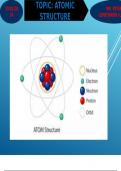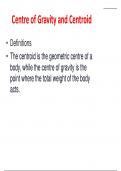TOP SELLERS shop
HERE I SHARE SOME OF MY WORK THAT I THINK IS OF IMPORTANCE TO EVERY STUDENT IN THE WORLD. GET YOURSELF THE BEST TRAINING AND REVISON MATERIAL AS YOU WAIT FOR YOUR EXAMS
ASSIGNMENTS, CASE STUDY, Q&A, DISSCUSSIONS, ESSAY, RESEARCH, DISSCUSSIONS etc
- 214
- 0
- 23
Community
- Followers
- Following
237 items

ATOMIC STRUCTURE INORGANIC CHEMISTRY
Atomic structure is a fundamental concept in chemistry that describes the arrangement of subatomic particles within an atom. It provides the foundation for understanding chemical bonding, reactions, and the behavior of elements in the periodic table. Atoms are the basic building blocks of matter and consist of a nucleus and electrons. #### **Key Components of Atomic Structure**: 1. **Nucleus**: - The nucleus is the dense, central part of an atom, containing positively charged **protons...
- Class notes
- • 42 pages •
Atomic structure is a fundamental concept in chemistry that describes the arrangement of subatomic particles within an atom. It provides the foundation for understanding chemical bonding, reactions, and the behavior of elements in the periodic table. Atoms are the basic building blocks of matter and consist of a nucleus and electrons. #### **Key Components of Atomic Structure**: 1. **Nucleus**: - The nucleus is the dense, central part of an atom, containing positively charged **protons...

INTRODUCTION TO FOOD SCIENCE AND HOSPITALITY
**Introduction to Food Science and Hospitality** is a foundational course that covers the principles of food science, the science behind cooking, and the operations of the hospitality industry. It explores the interaction between food, its preparation, and the consumer experience, as well as the role of hospitality services in society. The course provides an understanding of food safety, nutrition, and the hospitality industry's impact on global economies. --- #### **Key Concepts in Foo...
- Class notes
- • 33 pages •
-
• AFM 2101
**Introduction to Food Science and Hospitality** is a foundational course that covers the principles of food science, the science behind cooking, and the operations of the hospitality industry. It explores the interaction between food, its preparation, and the consumer experience, as well as the role of hospitality services in society. The course provides an understanding of food safety, nutrition, and the hospitality industry's impact on global economies. --- #### **Key Concepts in Foo...

SCH 2107-INORGANIC CHEMISTRY NOTES TOPIC: ATOMIC STRUCTURE PART 2
Atomic structure is a fundamental concept in chemistry that describes the arrangement of subatomic particles within an atom. It provides the foundation for understanding chemical bonding, reactions, and the behavior of elements in the periodic table. Atoms are the basic building blocks of matter and consist of a nucleus and electrons. #### **Key Components of Atomic Structure**: 1. **Nucleus**: - The nucleus is the dense, central part of an atom, containing positively charged **protons...
- Class notes
- • 34 pages •
-
• SCH 2107
Atomic structure is a fundamental concept in chemistry that describes the arrangement of subatomic particles within an atom. It provides the foundation for understanding chemical bonding, reactions, and the behavior of elements in the periodic table. Atoms are the basic building blocks of matter and consist of a nucleus and electrons. #### **Key Components of Atomic Structure**: 1. **Nucleus**: - The nucleus is the dense, central part of an atom, containing positively charged **protons...

thermodynamics
Thermodynamics is a branch of physics that deals with the relationships between heat, energy, and work. It focuses on how energy is transferred within a system and between systems and their surroundings. Thermodynamics is fundamental to understanding physical and chemical processes, as well as the principles governing engines, refrigerators, and numerous natural phenomena. --- #### **Key Concepts in Thermodynamics**: 1. **System and Surroundings**: - A **system** refers to the portion...
- Class notes
- • 18 pages •
-
• SPH 2160
Thermodynamics is a branch of physics that deals with the relationships between heat, energy, and work. It focuses on how energy is transferred within a system and between systems and their surroundings. Thermodynamics is fundamental to understanding physical and chemical processes, as well as the principles governing engines, refrigerators, and numerous natural phenomena. --- #### **Key Concepts in Thermodynamics**: 1. **System and Surroundings**: - A **system** refers to the portion...

NEWTONS LAWS OF MOTION
Newton's Laws of Motion, formulated by Sir Isaac Newton, describe the relationship between the motion of an object and the forces acting upon it. These laws form the foundation of classical mechanics and explain how objects behave under the influence of forces. #### **1. Newton's First Law (Law of Inertia):** - **Statement**: An object will remain at rest or continue in uniform motion in a straight line unless acted upon by an external force. - **Explanation**: - If no net force ac...
- Class notes
- • 22 pages •
-
• sph 2160
Newton's Laws of Motion, formulated by Sir Isaac Newton, describe the relationship between the motion of an object and the forces acting upon it. These laws form the foundation of classical mechanics and explain how objects behave under the influence of forces. #### **1. Newton's First Law (Law of Inertia):** - **Statement**: An object will remain at rest or continue in uniform motion in a straight line unless acted upon by an external force. - **Explanation**: - If no net force ac...

centroids centres of gravity and friction
1. **Centroids**: - The centroid is the geometric center of a plane figure or object. It is the point where the shape's area or volume can be considered to be concentrated for calculations. - For regular shapes (e.g., triangles, rectangles, circles), the centroid lies at a well-defined position, typically at the intersection of symmetry axes. - **Applications**: - Structural analysis: Determining the center of mass distribution in beams or columns. - Mechanical design: Locating the c...
- Class notes
- • 21 pages •
-
• sph 2160
1. **Centroids**: - The centroid is the geometric center of a plane figure or object. It is the point where the shape's area or volume can be considered to be concentrated for calculations. - For regular shapes (e.g., triangles, rectangles, circles), the centroid lies at a well-defined position, typically at the intersection of symmetry axes. - **Applications**: - Structural analysis: Determining the center of mass distribution in beams or columns. - Mechanical design: Locating the c...

physics 1
Forces in a plane, Forces in space, Rigid bodies, Equilibrium of rigid bodies. Distributed forces, Centroids and centres of gravity. Analysis of structures. Forces in beam and cables. Friction. Moments of inertia.
- Class notes
- • 20 pages •
-
• sph 2160
Forces in a plane, Forces in space, Rigid bodies, Equilibrium of rigid bodies. Distributed forces, Centroids and centres of gravity. Analysis of structures. Forces in beam and cables. Friction. Moments of inertia.

Role of plant growth regulators
Plant Growth Regulators (PGRs) are natural or synthetic compounds that influence various physiological processes in plants, including growth, development, and response to environmental stimuli. These chemicals act as signaling molecules, modulating cellular activities and coordinating the growth and behavior of plants. #### Types of Plant Growth Regulators and Their Roles: 1. **Auxins**: - **Functions**: Promote cell elongation, root initiation, and differentiation. They also regulate...
- Class notes
- • 6 pages •
-
• sbt 2110
Plant Growth Regulators (PGRs) are natural or synthetic compounds that influence various physiological processes in plants, including growth, development, and response to environmental stimuli. These chemicals act as signaling molecules, modulating cellular activities and coordinating the growth and behavior of plants. #### Types of Plant Growth Regulators and Their Roles: 1. **Auxins**: - **Functions**: Promote cell elongation, root initiation, and differentiation. They also regulate...

CELL AS THE UNIT OF STRUCTURE AND FUNCTION IN PLANTS
The cell is the fundamental unit of structure and function in plants, forming the basic building block of all plant life. It is the smallest unit capable of performing all the essential processes that sustain life, including growth, metabolism, reproduction, and response to the environment. Plant cells are distinct from other eukaryotic cells due to their unique structures like the cell wall, chloroplasts, and central vacuole. #### Key Features of Plant Cells: 1. **Cell Wall**: A rigid, prot...
- Class notes
- • 40 pages •
-
• sbt 2110
The cell is the fundamental unit of structure and function in plants, forming the basic building block of all plant life. It is the smallest unit capable of performing all the essential processes that sustain life, including growth, metabolism, reproduction, and response to the environment. Plant cells are distinct from other eukaryotic cells due to their unique structures like the cell wall, chloroplasts, and central vacuole. #### Key Features of Plant Cells: 1. **Cell Wall**: A rigid, prot...

PLANT ANATOMY
Plant anatomy is the branch of botany that focuses on the internal structure and organization of plants. It involves studying the cells, tissues, and organs of plants to understand their functions, growth, and development. Plant anatomy provides insights into how plants adapt to their environment and how their structures support physiological processes. #### Key Components of Plant Anatomy: 1. **Cells**: The basic unit of plant structure, including specialized cells such as parenchyma, colle...
- Class notes
- • 10 pages •
-
• SBT 2110
Plant anatomy is the branch of botany that focuses on the internal structure and organization of plants. It involves studying the cells, tissues, and organs of plants to understand their functions, growth, and development. Plant anatomy provides insights into how plants adapt to their environment and how their structures support physiological processes. #### Key Components of Plant Anatomy: 1. **Cells**: The basic unit of plant structure, including specialized cells such as parenchyma, colle...
